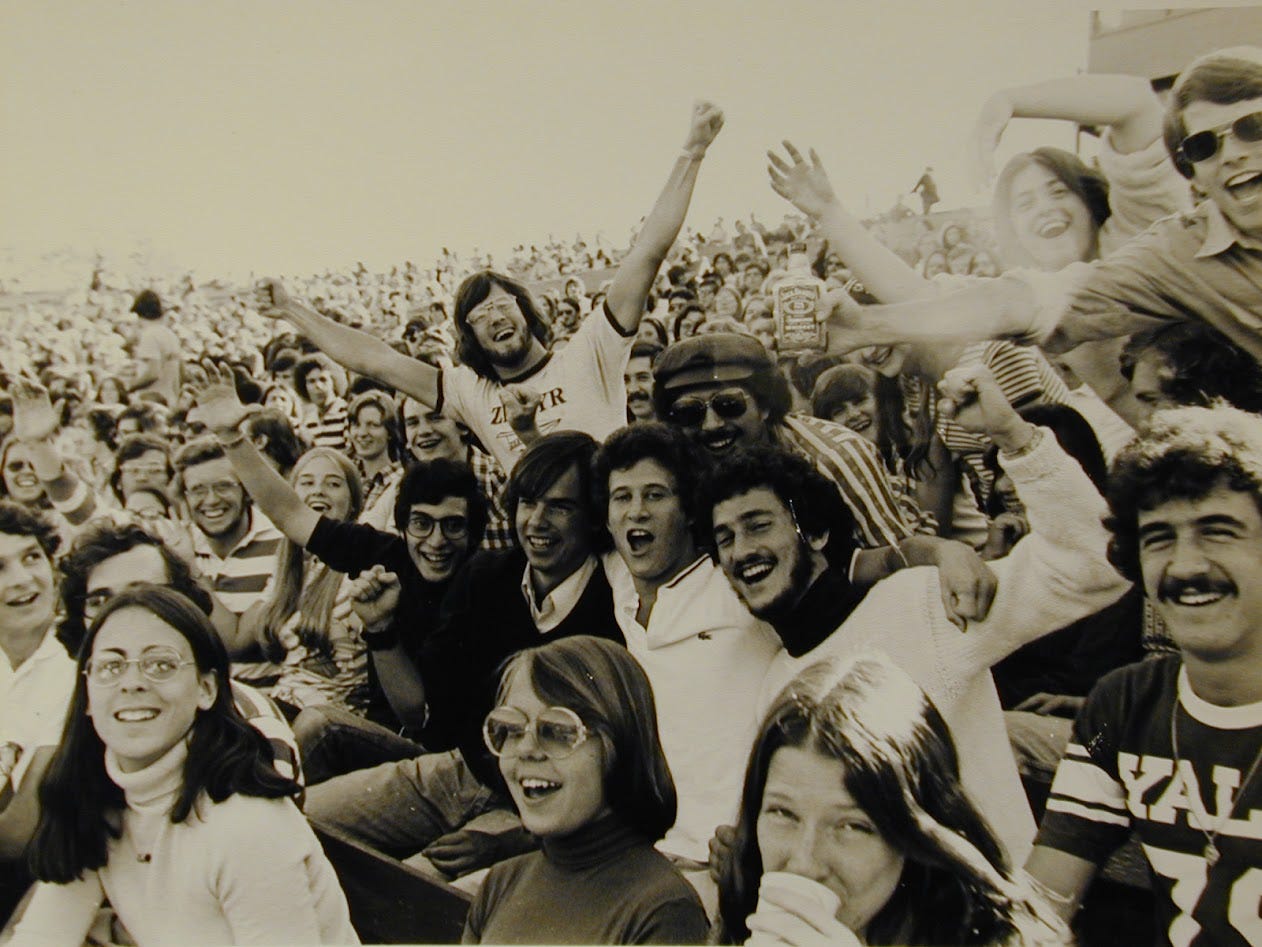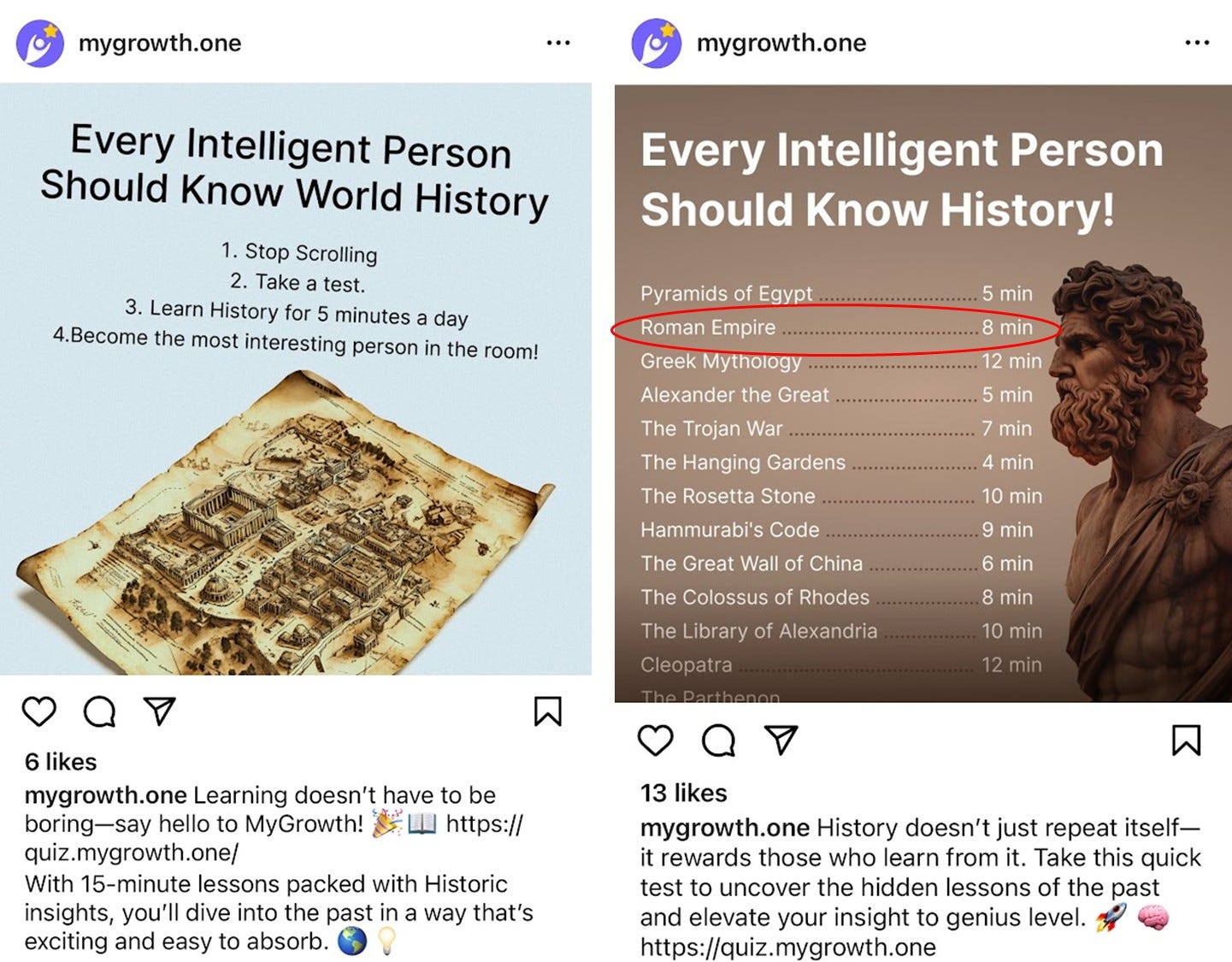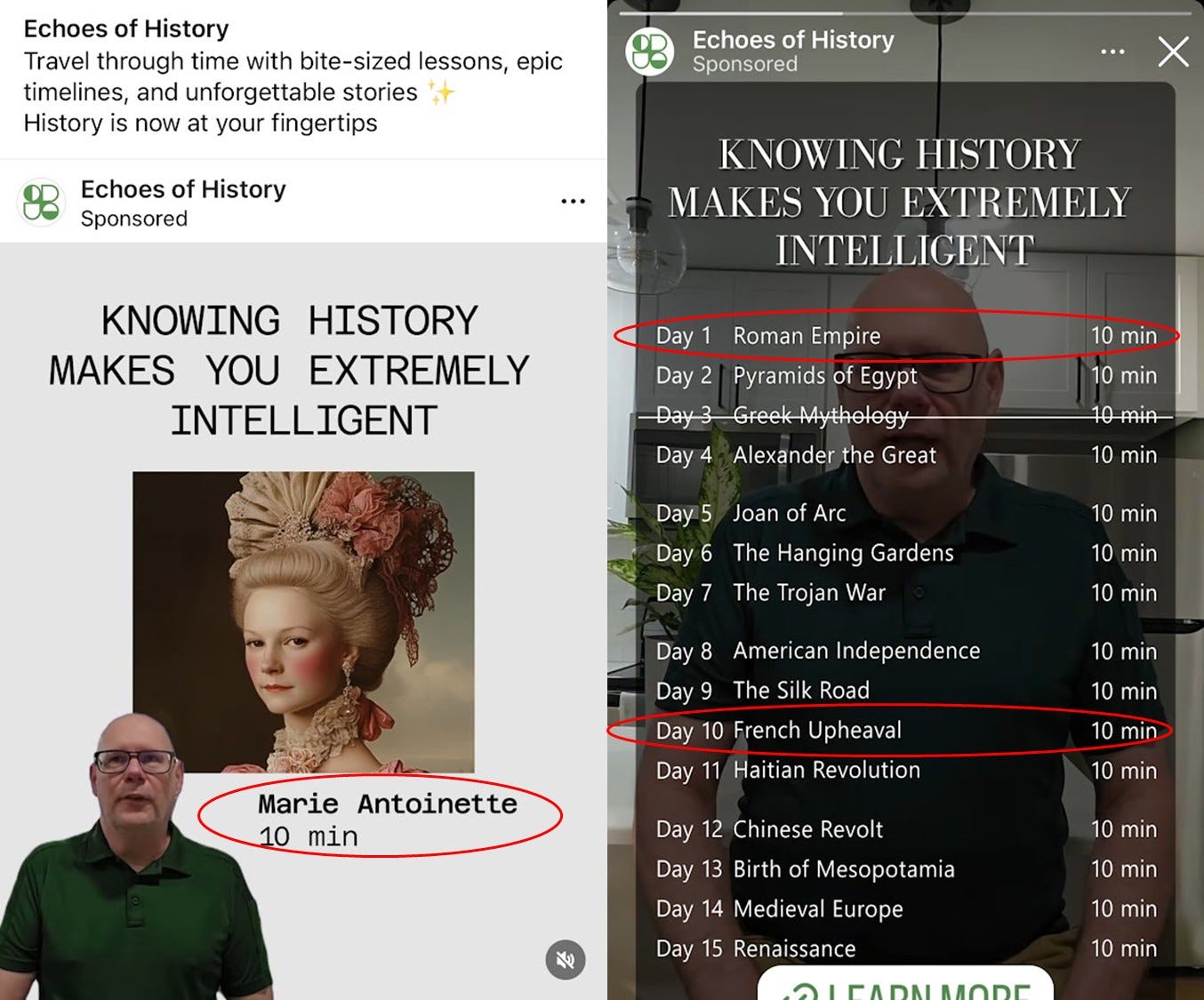Meandering Tour
College Friends | Roman Empire | Jaywalking | Fantasy Sports | Merch Giveaway
5) Bright College Peers
Last weekend, I went to a milestone birthday party in Connecticut for my dear college friend Doug, attended by several others who lived with us in the same residential college dormitory back in the day. As I’m trying to attract a younger readership, I’d prefer not to specify how long ago that was. Suffice it to say, we’ve all remained close friends for decades.
Here we were in 19XX at a college football game. I’m in the middle wearing a white polo shirt; a bearded Doug is to the right, a boyish Colin to the left. We were there that day to watch our friend Ken play defensive back. All four of us, along with other college friends, attended Doug’s party Saturday evening. The jokes flowed easily, as if we were sitting around our dorm room.
How do such friendships form — and endure? In many different ways, of course, including neighborhoods, the military, sports, the workplace. A number of formal studies suggest that college roommates who had positive relationships are significantly more likely to maintain contact for long periods of time after graduation.1 The explanation, according to the studies: factors such as sharing personal space, daily routines, and life transitions. These ties are, not surprisingly, reinforced by sustained efforts over the years to maintain relationships forged in college.
Our longstanding bonds have been strengthened by relative geographical proximity; most of us have lived our lives on the East Coast. We have informal get-togethers from time to time as well as more formal events where we see one another, such as our kids’ weddings. Our spouses have become friendly and, in some cases, our kids have gotten acquainted. The advent of e-mail and text has provided an effective way to keep our connections up-to-date.
And then there are Doug’s newspaper and magazine clippings, which he sends, often highlighted or underlined, at a pace and volume which are staggering in light of his prodigious professional, family, and volunteer commitments, and which might, in fact, account for the U.S. Postal Service’s current deficits.
Below (and I’m not making this up) is a photo of the clippings that have arrived in my mailbox from Doug over the past 72 hours.
His clippings are invariably relevant to my interests, often marked with a circulation list of other friends who are receiving the same article, and come from a wide array of sources. I once received an envelope that contained clippings from Vanity Fair, The Wall Street Journal, Caribbean Travel, a Restoration Hardware catalog, and The Boston Globe.
The Harvard Study of Adult Development, a longitudinal study that began in 1938, has found that strong friendships, more so than career achievement, money, fame, exercise, or diet, are the primary drivers of happiness and well-being. As such, the recycling load is a small price to pay for these clippings.
And as Doug is fond of saying, “You can’t make new, old friends.”
4) Shermanus Cerebrum Minimum
In light of our current political and cultural crisis, I thought it would be instructive to read The History of the Decline and Fall of the Roman Empire, Edward Gibbon’s late 18th century masterpiece. Did you know that it was published in six volumes and runs about 3,600 pages? The American Empire could vanish long before I finish reading it. (And that’s even if I start the book immediately rather than putting it on my bedside table with all the other books I haven’t read yet.)
Last weekend, an erudite friend told me he’s reading the abridged edition, which is 848 pages long. Nope.
Instead, I shamelessly paid for and downloaded a 30-page summary from CliffsNotes,2 whose slogan is, “The notes you need. The grades you want.” I am ashamed, however, to admit that I was worn out after six pages, so I fed all 30 pages into DeepSeek, the AI platform, which boiled them down to the following 218 words in under 10 seconds:
Loss of Virtue and Liberty
Gibbon identifies the decline of civic and private virtue as central to Rome's fall. He argues that the erosion of political freedom under imperial rule weakened the moral and social fabric of Roman society, leading to corruption, apathy, and dependency.Stages of Decline
Late Republic: Civil wars, slavery, and economic disparities eroded republican values.
Imperial Era: Despite prosperity under emperors like Augustus and Marcus Aurelius, the loss of liberty and reliance on professional armies sowed seeds of decay.
Third Century Onward: Centralization, bureaucratic oppression, heavy taxation, and barbarian invasions accelerated decline, culminating in the fall of the Western Empire in 476 AD.
Military and Political Corruption
The transition from citizen armies to mercenary forces undermined patriotism and discipline. Military leaders increasingly seized power, destabilizing the state. Gibbon critiques emperors like Septimius Severus for centralizing authority and eliminating checks on power.Economic and Social Decay
Excessive taxation, bureaucratic bloat, and economic stagnation discouraged productivity. The middle class dwindled, and cultural and intellectual vitality waned as freedom and creativity were stifled.Role of Christianity and Barbarians
While Christianity is noted for fostering otherworldliness and theological disputes, Gibbon emphasizes that internal decay—loss of virtue, liberty, and institutional resilience—made Rome vulnerable to external threats like barbarian invasions.
Sic transit gloria mentis.
Postscript: As I was finishing this edition, I was fed an Instagram ad from MyGrowth, whose mission is to “make history accessible, engaging, and relevant through micro-learning experiences that fit seamlessly into your daily routine.” One of the course offerings: “Roman Empire ………….. 8 min.”
3) Walk the Line
I had breakfast last month with Russ Roberston, the founder of Cap Ex Advisory Group, a consulting firm I worked with on a project during the COVID pandemic. Russ was talking about entrepreneurs, who take calculated risks they believe they can control.
He noted, by way of analogy, that a mid-block crossing is perceived by some as safer than crossing at an intersection. Why? Because pedestrian safety at a crosswalk depends in part on external factors such as functioning lights and crossing devices, the care and attention of drivers, their observance of no-turn-on-red signs, etc.
“The innovators I work with tend to believe they take less risk by bucking trends and crossing mid-block,” Russ explained, speaking figuratively about jay-walking. “They feel they can see and manage oncoming threats more clearly than at the cross-walk.”
I had never thought about this, even though I am an inveterate jaywalker, to the dismay of my wife. I never feel as if I am in danger but rather in complete control of the situation, able to see oncoming vehicles and adjust accordingly.
Why do I do it? Not to feel safer or to buck trends or to take calculated risks for my start-up Substack enterptrise. Instead, I am, by nature, always in a hurry and just too lazy to walk to the intersection.
Reddit threads are full of comments about the safety advantages of jaywalking — and counterarguments, of course. In 2009, Slate published an article by Tom Vanderbilt, author of Traffic: Why We Drive the Way We Do, titled “In Defense of Jaywalking: Banning the practice won’t make pedestrians safer.” According to state and national statistics in the article, “While jaywalking is often cited as a cause of pedestrian accidents, less than 20 percent of fatalities occurred where a pedestrian was crossing outside an easily available crosswalk.” Additional clicking around the Internet reveals that estimate might be too low.
In 2018, an op-ed in the Los Angeles Times questioned why, at a time of increasing pedestrian deaths, the police were focusing more on the victims than the drivers. “The LAPD is intentionally putting the responsibility for street safety on pedestrians,” the writer complained, “even though motorists control the cars that kill,” adding, “When motorists see a green light, they tend to ignore that there is also a sign for pedestrians giving them the right of way before drivers can make their turns through the crosswalk.” (Wait, I thought “Nobody Walks in L.A.”)

One reader responded in a letter to the editor, “I have been jaywalking for the past 30 years. I find it so much safer than walking inside marked crosswalks. When I jaywalk, I am so much more mindful of what is going on around me.”
And wouldn’t you know it? In September 2022, California Governor Gavin Newsom signed a bill, called “The Freedom to Walk Act,” decriminalizing jaywalking in the Golden State. Virginia (2020) and Nevada (2021) have done so as well, according to America Walks, an advocacy organization, which “supports decriminalizing jaywalking as a step towards more equitable walkable communities.”
My tendency to meander would typically compel me to prattle on about the fascinating information I’ve now learned about jaywalking (check out this footnote3 if you’re interested in a bullet point summary), but I won’t, because I know what some of you are thinking: Didn’t I write two weeks ago about the shopping cart theory, which posits that a person's moral character and self-control can by judged by whether he or she returns a shopping cart to its designated area.
Yes, I did, but jaywalking strikes me as quite different. Sure, I’m exhibiting a lack of self-control (I’m in a hurry), but jaywalking has nothing to do with my moral character, does it? Oh, except that I’m violating the law. But I’m not inconveniencing anyone, am I? But what about modeling behavior for my children and grandchildren?
I shall reassess.
2) Sidetracks
Replay: Several subscribers said they missed the actual song about Meandering Tour, prompted by my niece Nora, who instructed DeepAI.org, “Write a theme song for the Substack written by Scott Sherman called Meandering Tour. The song should sound like James Taylor and make self-deprecating jokes about his obsession with grammar and sweating the small stuff.” Here, again, is the AI-generated result.
Fantasy Sports: From MIT News: “Ping pong bot returns shots with high-speed precision.” Here’s the article and a demonstration video (start around the 45 second mark). Science magazine reported on bipedal robots “teaching themselves” how to improve at soccer. Here’s the article and a video. Don’t get me started on the increasingly sophisticated marriage of AI and robotics.
Krazy Kin: Nameberry Newsletter reported on the 2024 U.S. baby name data just released by the Social Security Administration, with a focus on the important question of how “eyebrow-raising” celebrity baby names of 2022 have fared, by comparing their pre-celebrity usage, in 2021, with statistics from 2023 and 2024. Why? To assess the short-term influence of celebrity-inspired names. Below are a few examples that are trending up (followed by the parents’ names), and here’s a link to the complete list.
Let Them Eat Bivalves: I’m fascinated by the history of the French Revolution, but, as is the case with the fall of the Roman Empire, I don’t have the patience to read deeply about it. Instead, I have contented myself with the web site French Revolution: Last Words of Those Who Died, which quotes the final utterances of some of those who were guillotined. The following entry, whose reference to “lack of civic virtue” echoes a key theme of The History of the Decline and Fall of the Roman Empire, caught my eye:
“Mon ami, veux-tu bien permettre que je finisse ma dernière douzaine d’huitres?
My friend will you let me finish my last dozen oysters?
Once a great friend to Marie Antoinette, Armand Louis de Gontaut, Duke of Biron, was convicted of incivisme (lack of civic virtue). When the executioner came and told him everything was ready for his execution, these were his last words to him.”And then this pops up on my Instagram feed: “bite-sized lessons” on the French Revolution from an outfit called Echoes of History (tagline: “Knowing history makes you extremely intelligent”), which links to an app called Smarty Pants. It looked suspicious to me, so I backed off, although I wouldn’t use them anyway because Smarty Pants takes 2 minutes longer (10) to cover the Roman Empire than OneGrowth (8). (See Item 4 above.)
1) Merch Giveaway
We finally resolved the merch debate at the Meandering Tour strategic planning retreat, held last week at the Meander Creek conference center near Austintown, Ohio.
Instead of redesigning the mock-ups of our fashion accessories, which one reader called “hideously ugly” and another dubbed “PowerPoint Early 2000s” (PPE2), we’re going to stick with the originals. (A rather sophisticated New Yorker, who wrote supportively that the tote bag could be an ur exemplar of PPE2, should be pleased.)
And rather than charging for the merch, we’re going to give it away, to readers who refer friends to our community. If at least three (3) referrals subscribe at no cost, you will receive SWAG for free.
Our marketing consultant is strongly opposed to this strategy, suggesting that the prospect of receiving any of these items, as currently designed, actually will provide a strong disincentive to recommend Meandering Tour to anyone.
I’m taking a calculated risk, crossing the street mid-block, if you will.
Erb, Renshaw, Short, Pollard (2014). The Importance of College Roommate Relationships: A Review and Systemic Conceptualization. Journal of Student Affairs Research and Practice, 51(1)
Ledbetter, Griffin, Sparks (2007). Forecasting “friends forever”: A longitudinal investigation of sustained closeness between best friends. Personal Relationships, 14, 343–350.
Lukens, Firmin, Broadhurst (2022). The Impact of Residential Life on the Development of Long-Term Relationships in Higher Education. College Student Affairs Journal, Volume 40(2).
Mayhew, Rockenbach, Bowman, Seifert, Wolniak (2016). How college affects students: 21st century evidence that higher education works (Vol. 3). John Wiley & Sons.
McCabe, J. M. (2016). Connecting in college: How friendship networks matter for academic and social success. University of Chicago Press.
Oswald, Clark (2003). Best friends forever? College roommate friendships over time.
I had no idea there is an “s” in the middle of CliffsNotes, launched in 1958 by Clifton K. Hillegass.
The etymology of the term.
“The forgotten history of how automakers invented the crime of jaywalking.”
Artificial neural networks to predict a jaywalker’s trajectory while crossing the street (to get to the other side?), with input variables such as gender, direction of crossing, walking or running, cell phone use, roadway lane number, etc.
State-by-state compendia of cross-walk laws, such as this one compiled by the Wisconsin-based Matthiesen, Wickert & Lehrer, which bills itself as “America’s Subrogation Law Firm.”
What happens if you hit someone who is jaywalking, by Melrose Law of Asheville, NC?
A quantitative analysis of New York jaywalking citations from 2006 to 2022 across different census tracts, with population make-up being a consistent predictive factor.
A meta-analysis of the effects of obedient and disobedient model behavior on the incidence of pedestrian jaywalking.
Oh, so you think there can’t possibly be enough separate studies to support a meta-analysis? Well, how about this 1982 thesis titled “The Social Psychology of Imitated Jaywalking: An Extension of Model Sex and Social Status,” based on a field experiment?
Plural possessive demonstration opportunity: Bronze is the Mahomeses’ son?










I too am fascinated by the French Revolution and have read many books and listened to several podcasts about it. One book,Citizens, is a must read. It is a history by the great British Historian and Art Historian Simon Schama that is not only history brought to life but a close study of the art of the Revolution. But for me it is the novel A Place of Greater Safety by the multiple Booker Prize winning author Hilary Mantel that cemented my interest. Mantel as you know also wrote the Wolf Hall trilogy about Henry VIII. Books I have been trying to get you to read for years or every time you ask me for a recommendation.
Love the ruminations and old friends and why those relationships endure. They are increasingly meaningful.